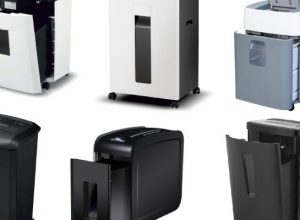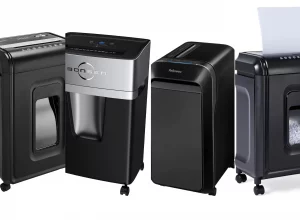Contents
Strip-Cut vs Cross-Cut vs Micro-Cut: Understanding Shredder Types
When it comes to document destruction, choosing the right shredder is crucial for ensuring the confidentiality of sensitive information. This article delves into the three predominant types of shredders: strip-cut, cross-cut, and micro-cut. Each type has its distinct functionality, security level, and ideal use cases, making it essential to understand their differences before making a selection.
Strip-Cut Shredders
Strip-cut shredders operate by cutting paper into thin strips, typically ranging from 1/4 inch to 1/2 inch in width. They work using a series of blades that slice the paper as it passes through the machine, making these devices one of the simplest types of shredders available. This basic cutting mechanism allows for a speedier shredding process compared to more complex shredding types, such as cross-cut or micro-cut shredders. For instance, in a bustling office environment where time efficiency is crucial, a strip-cut shredder may quickly process vast amounts of paper, allowing employees to focus on more productive tasks.
Advantages
- Speed: Strip-cut shredders are generally faster than their counterparts due to their simpler cutting mechanism. This increased speed can significantly enhance productivity in time-sensitive situations where large volumes of paperwork must be destroyed quickly.
- Cost-effective: They typically come at a lower price point, making them accessible for both home and small office use. Many consumers find that the initial investment in a strip-cut shredder pays off due to its longevity and the ease of handling non-confidential documents.
Disadvantages
- Security: The strips can potentially be reassembled, making them less secure for sensitive documents. For example, if an individual were to dispose of confidential business data using a strip-cut shredder, a determined individual might be able to piece together the information, leading to potential data breaches.
- Storage: The resulting strips take up more space if not properly disposed of. Users often find that, when shredded material is not appropriately managed—either through recycling or secure disposal—it can lead to clutter or environmental concerns.
Best Use Cases
For documents that do not carry sensitive information, such as old receipts or non-confidential documents, strip-cut shredders provide an efficient solution. For instance, a business that needs to keep records of transactions but does not handle sensitive personal information could effectively use a strip-cut shredder to fulfill its compliance requirements without the need for a more expensive and complex shredding solution.
Strip-Cut Shredders vs Cross-Cut vs Micro-Cut
Compared to cross-cut and micro-cut shredders, which enhance security by cutting paper into smaller pieces, strip-cut shredders are less secure. Cross-cut shredders cut paper into confetti-like pieces, casting more shadows over potential reassembly, while micro-cut shredders create tiny particles that are nearly impossible to reconstitute. As such, the choice of shredder type largely depends on the sensitivity of the documents being destroyed. The following table highlights these distinctions:
| Shredder Type | Cutting Method | Security Level | Best Use Cases |
|---|---|---|---|
| Strip-Cut | Cuts paper into long strips | Low | Non-confidential documents, old receipts |
| Cross-Cut | Cuts paper into smaller pieces (confetti) | Medium | General office use, moderately sensitive information |
| Micro-Cut | Cuts paper into tiny particles | High | Highly sensitive documents, personal information |
Cross-Cut Shredders
Cross-cut shredders enhance security by cutting paper into small confetti-like pieces, typically measuring 1/8 inch by 1 inch. The cross-cutting mechanism involves two sets of blades that work at different angles to create the shreds.
Advantages
- Enhanced Security: Cross-cut shredders offer a higher level of security since the small pieces are much more difficult to reassemble.
- Compactness: The shreds take up less space, which can be advantageous for storage and disposal.
Disadvantages
- Speed: These shredders operate more slowly compared to strip-cut shredders due to their more complex cutting mechanism.
- Price: Cross-cut shredders are generally more expensive than strip-cut models.
Best Use Cases
Cross-cut shredders are ideal for sensitive information such as bank statements, medical records, and other private documents that require a higher level of security.
Micro-Cut Shredders
Micro-cut shredders take security a step further by turning paper into extremely small particles, often measuring 1/16 inch by 1/2 inch or smaller. This shredding method is regarded as the most secure among the three types.
Advantages
- Highest Security: The tiny particles are virtually impossible to reassemble, making micro-cut shredders the go-to option for utmost security.
- Disposal: The minimal size of the shreds makes for easier disposal and less waste.
Disadvantages
- Speed: Micro-cut shredders have the slowest operation speed due to the complexity of the cutting mechanism.
- Cost: They often come at the highest price point in comparison to strip-cut and cross-cut shredders.
Best Use Cases
Micro-cut shredders are perfect for companies or individuals handling highly confidential information, such as legal documents, corporate secrets, or identities, needing the highest level of protection.
Comparison Table
| Shredder Type | Cut Size | Speed | Security Level | Typical Use | Cost |
|---|---|---|---|---|---|
| Strip-Cut | 1/4 to 1/2 inch strips | Fast | Low | Non-confidential documents | Low |
| Cross-Cut | 1/8 inch by 1 inch pieces | Medium | Medium | Sensitive documents | Medium |
| Micro-Cut | 1/16 inch by 1/2 inch pieces | Slow | High | Highly confidential documents | High |
Conclusion
Choosing the right shredder encompasses evaluating the level of security required for document destruction. Strip-cut shredders are suitable for basic shredding needs, while cross-cut shredders provide a balance of security and efficiency. Micro-cut shredders represent the pinnacle of security for handling extremely sensitive information. Assess your specific needs to determine which shredder type best suits you.




